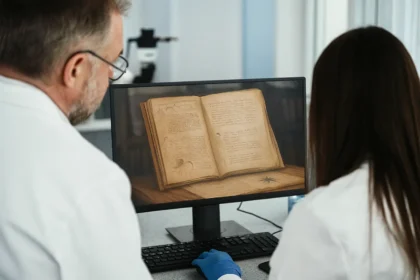Few mysteries are as captivating as the Voynich manuscript—an illustrated book written in a completely unknown language that has puzzled linguists, cryptographers, and historians for centuries. Despite countless attempts, no translation has ever been accepted. But in 2018, a new approach offered a glimmer of hope: artificial intelligence tries to decipher Voynich manuscript using algorithms capable of detecting hidden linguistic patterns.
The initiative came from a team at the University of Alberta in Canada, which applied modern natural language processing techniques to the mysterious text. The researchers wanted to go further—seeking out any logic behind the seemingly incomprehensible writing, and perhaps even identifying the language concealed in the code.
But did AI manage to solve the puzzle that has resisted decoding for over 600 years? Or did it simply add a new layer to the enigma?
Before we dive into how artificial intelligence was used to tackle this mysterious text, it’s worth remembering: the Voynich manuscript is a medieval book written in a completely unknown system, filled with enigmatic illustrations.
If you want to explore the full story of the manuscript—its origin, visual style, and the most popular theories—you can read our dedicated post:
What is the Voynich Manuscript? The indecipherable book that intrigues the world.
How artificial intelligence was applied to the text
In January 2018, Professor Greg Kondrak and PhD student Bradley Hauer, experts in computational linguistics, decided to apply natural language processing (NLP) techniques to the Voynich. Their goal was to find statistical patterns that might indicate a possible source language.
First, they transliterated the text—converting the manuscript’s symbols into a simplified alphabetic representation. Then, they fed the algorithm with versions of the Universal Declaration of Human Rights in 400 languages. The analysis of word patterns—such as frequency, structure, and repetition—produced an unexpected result: medieval Hebrew emerged as the closest match.
This finding drew attention because, until then, scholars had speculated that the manuscript might have been written in Latin, Arabic, or even an invented language.
The anagram translation attempt
After suggesting Hebrew as the base language, the AI moved on to the next step: rearranging the manuscript’s words as if they were anagrams—attempting to form real Hebrew words by reordering the letters.
Using this method, the system produced short sentences. The most widely cited was:
“She made recommendations to the priest, man of the house and people.”
Although the sentence appeared to make sense, serious doubts were raised:
There was no clear context indicating where in the manuscript the sentence came from.
The vocabulary, while recognizable, didn’t follow the narrative or grammatical structure of actual historical texts.
Why AI couldn’t translate the manuscript
Despite the initial excitement, experts pointed out serious limitations in the approach. The biggest one: AI can identify patterns, but it doesn’t understand meaning, context, or intent.
Some of the main issues included:
Artificial grammar: Even when the system used real Hebrew words, the sentences lacked narrative flow or historical coherence.
No external validation: No medieval Hebrew expert reviewed or confirmed that the output made sense within the real usage of the language.
Limited vocabulary: Many of the words were sourced from modern dictionaries, rather than reflecting the style or expressions of the time.
In short: the AI didn’t translate the manuscript. It only showed that the text shares formal features with real languages—especially Hebrew.
Other technologies used in the investigation
Meanwhile, researchers have also turned to another modern tool in the investigation: multispectral imaging.
This technique involves scanning the manuscript using different wavelengths of light (such as ultraviolet and infrared) to reveal layers that are invisible to the naked eye—including erasures, hidden ink, or pigment details.
The method has proven useful in other historical documents, like the Dead Sea Scrolls, and is already revealing signs that the Voynich manuscript may have been written by multiple authors. It may also help determine whether parts of the text were altered over time.
While AI searches for linguistic patterns, multispectral imaging brings physical clues—and together, these tools show that solving the mystery will require contributions from many fields of knowledge.
Conclusion
Artificial intelligence tries to decipher the Voynich manuscript, but it has yet to go beyond statistical hypotheses. It offered one lead: the text resembles medieval Hebrew. However, no one has been able to validate any of the generated sentences as a legitimate translation.
This case shows us AI’s potential as a support tool for historical research—but also its limits. On its own, it cannot solve the mystery. Linguists, historians, cryptographers, and data scientists must continue working together to decode the most enigmatic manuscript in history.
Perhaps the secret of the Voynich manuscript doesn’t lie only in what it says—but in what it compels us to seek: collaboration, patience, and the courage to face the unknown.
Explore more
The Zone of Silence in Mexico: the Bermuda Triangle of the desert
Acquired savants: brain injuries that awaken extraordinary talents
The disappearance of the Flannan Isles lighthouse keepers: a real mystery
References
Universidade de Alberta –
Using AI to uncover ancient mysteriesFagin Davis, Lisa
Topic Modeling in the Voynich ManuscriptScienceDaily
Mysterious Voynich manuscript dates back to early 15th century, researchers find
Posts Recomendados
Carregando recomendações...



